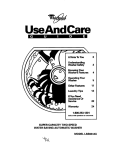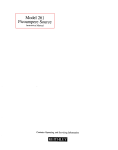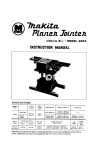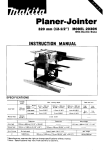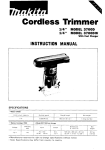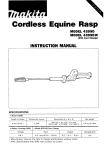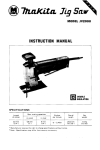Download Makita LS1211 Instruction manual
Transcript
Slide Compound Saw 305 mm (12”) MODEL L S l 2 1 l Equipped with Electric Brake INSTRUCTION MANUAL DOUBLE INSULATION SPECIFICATIONS Blade diameter .............................................................................................................. 305 mm 112") Arbor diameter .............................................................................................................. 25.4 mm 11") Max cutting capacities 1H x W ) Bevel angle Left 45" 00 I Right 45" 00 65 mm x 230 mm 12-9/16" x 9-1/16',) 49 mm x 230 mm *11-15/16" x 9-1/16',) .120 mm x 230 mm 14-3/4" x 9-1/16',) 57 mm x 290 mm 12-1/4" x 11-7/16") 40 mm x 290 mm 11-9/16" x 11-7/16") 107 mm x 290 mm 14-3/16" x 11-7/16") 48 mm x 310 mm 11-7/8" x 12-3/16") 31 mm x 310 mm 11-1/4" x 12-3/16") 94 mm x 310 mm 13-11/16" x 12-3/16") 65 mm x 162 mm 12-9/16'' X 6-3/8"1 49 mm x 162 mm 11-15/16" x 6-3/8"1 .120 mm x 162 mm (4-3/4" x 6-3/8"1 57 mm x 205 mm (2-1/4" x 8-1/16',) 4 0 mm x 205 mm 11-9/16" x 8-1/16',) 107 mm x 205 mm 14-3/16" x 8-1/16") 48 mm x 219 mm .11-7/8" x 8-5/8") 31 mm x 219 mm 11-1/4" x 8 - 5 / 8 " ) 94 mm x 219 mm 13-11/16" x 8-5/8") . Miter angle . Left and right 45O 1 -120mmx 115mm (4-3/4" x 4-112") 107 mm x 145 mm 14-3/16' x 5-1 1/16',) 94 mm x 155 mm 13-11/16" x 6-118"l [Note) mark indicates that a w o o d facing w i t h t h e following thickness is used. I I Miter angle I oo Left and right 45O No load speed (RPMl Thickness of wood facing 30 mm 11-3/16',) I 21 mm 113/16"1 ................................................................................................................ Dimensions (L x W x HI .............................. 4,000 .._.1,040 mm x 605 mm x 620 mm 140-15/16" x 23-13/16" x 24-7/16,') Net weight ....................... Manufacturer reserves t h e right t o change specifications w i t h o u t notice. Note: Specifications may differ f r o m c o u n t r y t o country. WARNING: For your personal safety, READ and UNDERSTAND before using. SAVE THESE INSTRUCTIONS FOR FUTURE REFERENCE. 2 For Your Own Safety Read Instruction Manual Before Operating Slide Compound Saw Save it for future reference GENERAL SAFETY PRECAUTIONS (For All Tools) 1. KNOW YOUR POWER TOOL. Read the owner’s manual carefully. Learn the tools applications and limitations, as well as the specific potential hazards peculiar t o it. 2. KEEP GUARDS I N PLACE and in working order. 3. REMOVE ADJUSTING KEYS A N D WRENCHES. Form habit of checking t o see t h a t keys and adjusting wrenches are removed from tool before turning it on. 4. KEEP WORK AREA CLEAN. Cluttered areas and benches invite accidents. 5. DON’T USE IN DANGEROUS ENVIRONMENT. Don’t use power tools in damp or w e t locations, or expose t h e m t o rain. Keep work area well lighted. Don’t use tool in presence of flammable liquids or gases. 6. KEEP CHILDREN AWAY. All visitors should be kept safe distance f r o m work area. 7. MAKE WORKSHOP CHILD PROOF with padlocks, master switches, or by removing starter keys. 8. DON‘T FORCE TOOL. It w i l l do the job better and safer at the rate for w h i c h it was designed. 9. USE RIGHT TOOL. Don’t force tool or attachment to d o a job for w h i c h it was n o t designed. IO. WEAR PROPER APPAREL. Wear no loose clothing, gloves, neckties, rings, bracelets, or other jewelry w h i c h may get caught in moving parts. Nonslip footwear is recommended. Wear protective hair covering t o contain long hair. 11. ALWAYS USE SAFETY GLASSES. Also use face or dust mask if cutting operation is dusty. Everyday eyeglasses only have impact resistant lenses, they are NOT safety glasses. 12. SECURE WORK. Use clamps or a vise t o hold work w h e n practical. It’s safer than using your hand and it frees both hands t o operate tool. 13. DON‘T OVERREACH. Keep proper footing and balance at all times. 14. MAINTAIN TOOLS WITH CARE. Keep tools sharp and clean for best and safest performance. Follow instructions for lubricating and changing accessories. 15. DISCONNECT TOOLS before servicing, w h e n changing accessories such as blades, bits, cutters, and the like. 3 16. EXTENSION CORDS. Make sure your extension cord is i n good condition. When using an extension cord, be sure to use one heavy enough to carry the current your product w i l l draw. An undersized cord will cause a drop in line voltage resulting in loss of power and overheating. Table 1 shows the correct size to use depending on cord length and nameplate ampere rating. If in doubt, use the next heavier gauge. The smaller the gauge number, the heavier the cord. TABLE 1 MINIMUM GAUGE FOR CORD SETS Total Length of Cord in Feet I 0 - 25 I 26 - 50 Ampere Rating More Not M O W Than Than 0 - 6 - 10 12 - 6 10 12 16 I 51 - 100 I 101 - 150 A W G 18 18 16 14 16 16 16 12 :t I 14 12 14 12 Not Recommended VOLTAGE WARNING: Before connecting the tool t o a power source (receptacle, outlet, etc.) be sure the voltage supplied is the same as t h a t specified o n the nameplate of the tool. A power source w i t h voltage greater than t h a t specified for the tool can result i n SERIOUS INJURY t o the user - as well as damage t o the tool. If in doubt, DO NOT PLUG IN THE TOOL. Using a power source w i t h voltage less than the nameplate rating is harmful t o the motor. ADDITIONAL SAFETY RULES 1. Wear eye protection. 2. Do n o t operate saw without guards in place. 3. Don't use the t o o l i n the presence of flammable liquids or gases. - 4. Check the blade carefully for cracks or damage before operation. Replace cracked or damaged blade immediately. 5. Use only flanges specified for this tool. 6. Be careful not t o damage the arbor, flanges (especially the installing surface) or bolt. Damage t o these parts could result in blade breakage. 7. Make sure that the turn base is properly secured so it w i l l not move during operation. 8. For your safety, remove the chips, small pieces, etc. from the table top before operation. 9. Avoid cutting nails. Inspect for and remove all nails from the workpiece before operation. IO. Make sure the shaft lock is released before the s w i t c h is turned on. 1 1. Be sure that the blade does not contact the turn base in the lowest position. 12. Hold the handle firmly. Be aware that the saw moves u p or d o w n slightly during start-up and stopping. 13. Do not perform any operation freehand. The workpiece must be secured firmly against the turn base and guide fence w i t h the vise during all operations. Never use your hand t o secure the workpiece. 14.Keep hands out of path of saw blade. Avoid contact w i t h any coasting blade. It can still cause severe injury. 15. Never reach around saw blade. 16. Make sure the blade is not contacting the workpiece before the s w i t c h is turned on. 17. Before using the tool o n an actual workpiece, let it run for a while. Watch for vibration or wobbling that could indicate poor installation or a poorly balanced blade. 18. Wait until the blade attains full speed before cutting. 19. Stop operation immediately i f you notice anything abnormal. 20. Do n o t attempt t o lock the trigger in the o n position. 21. Shut o f f power and wait for saw blade t o stop before servicing or adjusting tool. 22. Be alert at all times, especially during repetitive, monotonous operations. Don't be lulled into a false sense of security. Blades are extremely unforgiving. 23. Always use accessories recommended i n this manual. Use of improper accessories such as abrasive wheels may cause an injury. 24. Don't abuse cord. Never yank cord t o disconnect it from the receptacle. Keep cord away f r o m heat, oil, water and sharp edges. SAVE THESE INSTRUCTIONS. 5 Socket wrench Store the socket wrench in the wrench holder a t the rear of the tool after using it. Wrench holder 1 Bench mounting saw , When the tool is shipped, the handle is locked in the lowered position. Release the handle from the lowered position by lowering it slightly and removing the chain from the screw on the motor housing. I I I This tool should be bolted with two bolts to a level and stable surface using the bolt holes provided in the tool’s base. This will help prevent tipping and possible injury. 6 Chain Installing or removing saw blade CAUTION : Always be sure that the tool is switched off and unplugged before installing or removing the blade. Use the socket wrench to loosen the hex bolt which secures the center cover by turning counterclockwise. Raise the safety cover and the center cover. Socket wrenc Press the shaft lock to lock the spindle and use the socket wrench to loosen the hex bolt by turning it clockwise. Then remove the hex bolt, outer flange and blade. Hex bolt (left-handed) Socket wrench To install the blade, mount it carefully onto the spindle, making sure that the direction of the arrow on the surface of the blade matches the direction of the arrow on the blade case. \-Outer flange rSpindle Ring Inner flange Saw blade I - - Hex bolt (left-handed) 7 Install the outer flange and hex bolt, and then use the socket wrench to tighten the hex bolt securely by turning it counterclockwise while pressing the shaft lock. Return the safety cover and the center cover to the original position. Then tighten the hex bolt to secure the center cover. Lower the handle to make sure that the safety cover moves properly. I I /-Safety -Socket cover wrench CAUTION: Use only the Makita socket wrench provided to install or remove the blade. Failure to do so may result in overtightening or insufficient tightening of the hex bolt. This could cause serious injury to operator or others in the general vicinity of the tool. Safety cover -When lowering the handle, the safety cover rises automatically. The cover returns to i t s original position when the cut is complet d and the handle is raised. NEVER DEFE&T OR REMOVE THE SAFETY COVER. In the interest of your personal safety, always maintain the safety cover in good condition. Any irregular operation of the safety cover should be corrected immediately. NEVER USE THE TOOL WITH A FAULTY SAFETY COVER. If the see-through safety cover becomes dirty, or sawdust adheres to it in sucha way that the blade and/or workpiece is no longer easily visible, unplug the saw and clean the cover carefully with a damp cloth. Do not use solvents or any petroleum-based cleaners on the plastic cover. ~~ Dust bag To attach the dust bag, fit i t into the elbow. When the dust bag is about half full, remove the dust bag from the tool and pull the fastener out. Empty the dust bag by tapping it lightly to remove as much dust as possible. NOTE : If you connect a vacuum cleaner to your saw, more efficient and cleaner operations can be performed. 8 Positioning kerf boards This tool is provided with kerf boards in the turn base. The kerf boards are factory-adjusted so that the saw blade does not contact the kerf boards. Before use, adjust the kerf boards as follows: First unplug the tool. Loosen the a l l screws (2 each on left and right) which secure the kerf boards. Retighten them t o the extent that the kerf boards can be easily moved by hand. Loosen the clamp screw on the arm. Pull the carriage toward you fully and lower the handle fully. Adjust the kerf boards so that the kerf boards just contact the sides of blade teeth slightly. Tighten the front screws (do not tighten firmly). Push the carriage toward the guide fence fully and adjust the kerf boards so that the kerf boards just contact the sides of blade teeth slightly. Tighten the rear screws (do not tighten firmly). After adjusting the kerf boards, tighten the a l l screws securely. 1 Kerf board Left bevel cut Straight cut Right bevel cut CAUTION: After changing the bevel angle, always readjust the kerf boards as described above. 9 Maintaining maximum cutting capacity This tool I S factory adjusted to provided the max. cutting capacity for a 305 mm (12”) saw blade. When using a saw blade other than the 305 mm (12”) saw blade, adjust the lower limit position of the blade as follows: First unplug the tool. Push the carriage toward the guide fence fully and lower the handle completely. Use the socket wrench to turn the adjusting bolt until the periphery of the blade extends slightly below the top surface of the turn base at the point where the front face of the guide fence meets the top surface of the turn base. With the tool unplugged, rotate the blade by hand while holding the handle a l l the way down to be sure that the blade does not contact any part of the lower base. Re-adjust slightly, if necessary. I Periphery of blade n To surface of turn base Guide fence I I CAUTION : After installing a new blade, always be sure that the blade does not contact any Part of the lower base when the handle is lowered completely. Positioning for adjusting the miter angle The turn base turns up to 60” to the left and right. Loosen the grip and turn the turn base to the position where the pointer points to the desired angle on the miter scale. Then, tighten the grip firmly to secure turn base. I -Miter scale CAUTION : When turning the turn base, be sure to rasie the handle fully. After changing the miter angle, always secure the turn base by tightening the grip firmly. 10 Positioning for adjusting the bevel angle The saw blade t i l t s up t o 45" t o the left and right. To adjust the bevel angle, loosen the lever a t the rear of the tool. For left bevel cutting, tilt the saw blade t o the left until the pointer points t o the desired angle. Then tighten the lever firmly t o secure the arm. For right bevel cutting, press the release button after tilting the saw blade slightly t o the left. While pressing the release button, tilt the saw blade t o the right until the pointer points t o the desired angle. Then tighten the lever firmly to secure the arm. i-f- Tighten L CAUTION : *When tilting the saw blade, be sure to raise the handle fully. *After changing the bevel angle, always secure the arm by tightening the lever. *When changing bevel angles, be sure t o position the kerf boards appropriately as explained in the "Positioning kerf boards" section. 11 Securing workpiece WARNING: It i s extremely important to always secure the workpiece properly and tightely with the vise. Failure to do so can cause the tool to be damaged and/or the workpiece to be destroyed. PERSONAL INJURY MAY ALSO RESULT. Also, after any cutting operation, DO NOT raise the blade until the blade has come to a complete stop. 1. Vertical vise The vertical vise can be installed in two positions on either the left or right side of the guide fence, or holder assembly (optional accessory). Insert the vise rod into the hole in the guide fence or holder assembly and tighten the screw to secure the vise rod. (Note: When using the holder assembly, install it on the holder (optional accessory) as shown in the figure.) Position the vise arm according to the thickness and shape of the workpiece and secure the vise arm by tightenHolder H k r assembly ing the screw. Make sure that no part of the tool contacts the vise when lowering th. handle fully or when pulling or pushing the carriage. If some part contacts the vise, re-position the vise. Press the workpiece flat against the guide fence and the turn base. Position the workpiece a t the desired cutting position and secure it firmly by tightening the clamp screw of the vise. The maximum thickness of workpieces which can be secured by the vertical vise is 120 mm (4-3/4"). w CAUTION : The workpiece must always be secured firmly against the turn base and guide fence with the vise during all operations. 2. Horizontal vise (optional acccssory) The horizontal vise can be installed in two positions on either the left or right side of the base. When performing 15" or greater miter cuts, install the horizontal vise on the side opposite the direction in which the turn table is to be turned. By flipping the vise nut to the left, the vise is released, and rapidly moves in and out. To grip workpieces, push the vise knob forward until the vise plate contacts the workDiece and fliD the vise nirt to the right.' Then turn the vise knob clockwise to secure the workpiece. The maximum width of workpieces which can be secured by the horizontal vise is 200 mm (7-7/8"). CAUTION : Always set the vise nut to the right fully when securing the workpiece. Failure to do so may result in insufficient securing of the workpiece. This could cause the workpiece to be thrown, cause damage to the blade or cause the dangerous loss of control of the tool. 12 3. Holders and holder assembly (optional accessories) The holders and the holder assembly can be installed on either side as a convenient means of supporting workpieces horiziontally. Install them as shown in the figures. Then tighten the screws firmly to secure the holders and the holder assembly. CAUTION : Always support long workpieces level with the top surface of the turn base for accurate cuts and to prevent dangerous loss of control of the tuol. When installing the vertical vise on the holder assembly When securing wide workpieces -Vertical I - Holder assembly I Switch action To prevent the trigger from being accidentally actuated, a lock-off button is provided. To start the tool, press in the lock-off button and pull the trigger a t the same time. Release the trigger to stop. -Holder vise assembly Lock-off button Trigger switch I CAUTION : Before plugging in the tool, always check to see that the trigger switch actuates properly and returns to the "OFF" position when released. .When not using the tool, remove the lock-off button and store it in a secure place. This prevents unauthorized operation. *Do not pull the trigger hard without pressing in the lock-off button. This can cause breakage of the switch. 13 Operation CAUTION : .Make sure the blade is not contacting the workpiece, etc. before the switch is turned on. Do not apply excessive pressure on the handle when cutting. Too much force may result in overload of the motor and/or decreased cutting efficiency. *Gently press down the handle to perform the cut. If the handle is pressed down with force or if lateral force is applied, the blade will vibrate and leave a mark (saw mark) in the workpiece and the precision of the cut will be impaired. During a slide cut, gently push the carriage toward the guide fence without stopping. If the carriage movement i s stopped during the cut, a mark will be left in the workpiece and the precision of the cut will be impaired. 1. Press cutting (cutting small workpieces) Workpieces up to 94 mm (3-11/16") high and 130 mm (5-1/8") wide or 107 mm (4-3/16") high and 110 mm (4-5/16") wide can be cut in the following way. Push the carriage toward the guide fence fully and tighten the clamp screw on the arm to secure the carriage in the Lower gently "back" position. Secure the workpiece with a vise. Switch on the tool and wait until the blade attains full speed before lowering gently into the cut. When the cut is completed, switch off the tool and WAIT UNTIL THE BLADE HAS COME TO A COMPLETE STOP before returning the blade to i t s fully e Ievated position. CAUTION: Firmly tighten the clamp screw on the arm so that the carriage will not move during operation. Insufficient tightening may cause unexpected kickback of the blade. Possible serious injury may result. 14 2. Slide (push) cutting (cutting wide workpieces) Workpieces up t o 94 mm (3-11/16") high and 310 mm (12-3/16") wide or 107 m m (4-3/16") high and 290 mm (11-7/16") wide can be cut in the following way. Loosen the clamp screw on the arm so that the carriage can slide freely. Secure the workpiece with a vise. Pull the carriage toward you fully. Switch on the tool and wait until the blade attains full speed. Then gently lower the handle to the fully lowered position and PUSH THE CARRIAGE TOWARD THE GUIDE FENCE TO CUT THE WORKPIECE. When the cut i s completed, switch off the tool and WAIT UNTIL THE BLADE HAS COME TO A COMPLETE STOP before returning the blade to i t s fully elevated position. Holder assembly (Optional accessory) CAUTION: Whenever performing the slide cut, FIRST PULL THE CARRIAGE TOWARD YOU FULLY and press down the handle to the fully lowered position, then PUSH THE CARRIAGE TOWARD THE GUIDE FENCE. If you perform the slide cut without pulling the carriage fully or if you perform the slide cut toward your direction, the blade may kick back unexpectedly with the potential to cause serious injury. 3. Miter cutting Refer to the previously covered "Positioning for adjusting the miter angle". 4. Bevel cut Left and right 0" - 45" bevel cuts can be performed. A t a left 45" bevel angle, workpieces up to 48 mm (1-7/8") high and 310 mm (12-3/16") wide or 57 mm (2-1/4") high and 290 mm (11-7/16") wide can be cut. At a right 45" bevel angle, workpieces up to 31 mm (1-1/4") high and 310 mm (12-3/16") wide or 40 mm (1-9/16") high and 290 mm (11-7/16") wide can be cut. Loosen the lever and tilt the saw blade to set the bevel angle. Be sure to re-tighten the lever firmly to secure the selected bevel angle safely. Secure the worktiece with a vise. Switch on the tool and wait until the Apply pressure in blade attains full speed. Then gently lower the handle to the fully lowered position while applying pressure in parallel with the blade and PUSH THE CARRIAGE TOWARD THE GUIDE FENCE TO CUT THE WORKPIECE. When the cut is completed, switch off the tool and WAIT UNTIL THE BLADE HAS COME TO A COMPLETE STOP before returning the blade to i t s fully elevated position. 15 CAUTION : During a bevel cut, it may create a condition whereby the piece cut off will come to rest against the side of the blade. If the blade is raised while the blade is still rotating, this piece may be caught by the blade, causing fragments t o be scattered around which is dangerous. The blade should be raised ONLY after the blade has come to a complete stop. When pressing down the handle, apply pressure in parallel with the blade. If a force i s applied perpendicularly to the turn base or if the pressure direction is changed during a cut, the precision of the cut will be impaired. 5. Compound cutting Compound cutting i s the process in which a bevel angle is made a t the same time in which a miter angle i s being cut on a workpiece. Compound cutting can be performed a t angle shown in the table below. Bevel angle I Left and right 35" Left and right 0" - 30° 16 Miter angle Left and right 0 ' Left and right 45O 1 - 45' Left and right Oo - 55' Left and right Oa - 60' + 6. Cutting crown and cove moldings .Crown and cove moldings can be cut on a compound miter saw with the moldings laid f l a t on the turn base. *There are two common types of crown moldings and one type of cove molding: 52/38" wall angle crown molding, 45" wall angle crown molding and 45" wall angle cove molding. See illustrations below. Ceilling Cei IIing 45" type crown molding 52/38" type crown molding 45" type cove molding .There are crown and cove molding joints which are made to frt "Inside" 90" corners ( @ and @ In Fig. A) and "Outside" 90" corners (0 and @ in Fig A ) 38" or 45" inside corner w Outside corner Fig. U inside corner I7 When cutting crown and cove moldings, set the bevel angle and miter angle as indicated in the table ( A ) and position the moldings on the top surface of the saw base as indicated in the table (B). Table ( A I Molding position in Fig. (AI For inside corner Miter angle Bevel angle 52/38O type I 45O type 0 __ 0 33.90 30° Left 31.6O Left 35.3" 0 For outside corner @I Molding Molding edge against guide fence in Fig. ( A I Ceiling contact edge should be against guide fence. For inside corner Right 31.6O 1 Right 35.3" Finished piece Finished piece will be on the Left side of blade. 0 Wall contact edge should be m - against guide fence. For outside corner a Ceiling contact edge should be against guide fence. Finished piece will be on the Right side of blade. 7. Cutting aluminum extrusion When securing aluminum extrusions, use spacer blocks or pieces of scrap as shown in the figure to prevent deformation of the aluminum. Use a cutting lubricant on the blade teeth when cutting the aluminum extrusion to prevent build-up of the aluminum material on the blade. Aluminum extrusion n Spacer blocks Vertical vise Guide fe Horizontal vise I Spacer black CAUTION: Never attempt to cut thick or round aluminum extrusions. Thick aluminum extrusions may come loose during the cutting operation and round aluminum extrusions are very difficult to be secured firmly and safely with this tool. 8. Wood facing When cutting workpieces from 107 mm (4-3/16") to 120 mm (4-3/4") high, use a wood facing attached to the face of the guide fence to prevent a portion of the workpiece near the guide fence from being left uncut. Attach a straight wood board of even thick ness to the guide fence using the holes in the guide fence and screws. The screws should be installed so that their heads remain beneath the surface of the wood facing. See the figure below concerning the dimensions for a suggested wood facing. NOTE : When using a wood facing, the max. cutting width will be reduced by the thickness of the wood facing. Over 15 m m 1518"l Over 600 mm 123 518"l C (39/16") 14-15116") I4 1 5 / 1 6 ) 139116"l 19 Miter angle Thickness of wood facing 0" Over 30 mm ( 1-3/16") Over 21 mm (13/16") Left and rioht 45" Left and right 60" I Over 1 5 mm ( 9 / 1 6 " ) 9. Cutting repetitive lengths When cutting several pieces of stock to the same length, ranging from 305 mm (12") to 440 mm (17-5/16"), use of the set plate (optional accessory) will facilitate more efficient operation. Install the set plate on the holder (optional accessory) as shown in the figure. Align the cutting line on your workpiece with either the left or right side of the groove in the kerf board, and while holding the workpiece from moving, move the set plate flush against the end of the workpiece. Then secure the set plate with the screw. When the set plate is not used, loosen the screw and turn the set plate out of the way. 10. Groove cutting A dado type cut can be made by proceeding as follows: Adjust the lower limit position of the blade using the adjusting screw on the stopper arm to limit the cutting depth of the blade. To adjust it, rotate the stopper arm to the position shown in the figure. Adjust the adjusting screw so that the blade stops at the desired position when lowering the handle fully. After adjusting the lower limit position of the blade, cut parallel grooves across the width of the workpiece using a slide (push) cut as shown in the figure. Then remove the workpiece material between the grooves with a chisel. Do not attempt to perform this type of cut using wide (thick) blades or with a dado blade. Possible loss of control and injury may result. k Adjusting screw -Stopper arm I rn t Carrying tool Make sure that the tool isunplugged. Secure the blade a t 0" bevel angle and the turn base a t 60" miter angle to the right. Secure the slide pole after pulling the carriage toward you fully. Lower the handle fully and lock it in the lowered position by hooking the chain to the screw on the motor hous, ing. Carry the tool by holding both sides of the tool base as shown in the figure. If you remove the holders, dust bag, vise, tec., you can carry the tool more easily. CAUTION : Always secure all moving portions before carrying the tool 21 MAINTENANCE CAUTION : Always be sure that the tool is switched off and unplugged before attempting to perform inspection or maintenance. WARNING: Always be sure that the blade is sharp and clean for the best and safest performance. Adjusting the cutting angle This tool is carefully adjusted and aligned at the factory, but rough handling may have affected the alignment. If your tool i s not aligned properly, perform the following: 1) Miter angle Push the carriage toward the guide fence and tighten the clamp screw on the arm to secure the carriage in the "back" position. Loosen the grip which secures the turn base. Rotate the turn base so that the pointer points to 0" on the miter scale. Then turn the turn base slightly to the left and right to seat the turn base snugly in the 0" miter notch. (Leave as it is even if the pointer does not point to O".) Loosen the four hex bolts which secure the guide fence using the socket wrench. Lower the handle fully and square the side of the blade with the face of the guide fence using a triangular rule, trysquare, etc. Then securely tighten the hex bolts on the guide fence in order starting from left side. Make sure that the pointer points to 0" on the miter scale, If it does not point to 0". loosen the screw which secures the pointer and adjust it so that it will point to 0". 22 Guide fence 1 - ) 2) Bevel angle i)0" bevel angle Push the carriage toward the guide fence and tighten the clamp screw on the arm. Loosen the lever a t the rear of the tool. Turn the hex bolt (A) on the turn base two or three revolutions counterclockwise to tilt the blade to the right. Lower the handle fully and carefully square the side of the blade with top surface of the turn base using the triangular rule, try-square, etc. by turning the hex bolt (A) clockwise. Then tighten the lever securely. Make sure that the pointer on the arm points to 0" on the bevel scale on the arm holder. If it does not point to O", loosen the screw which secures the pointer and adjust it so that it will point to 0". 23 i i ) 45" bevel angle Adjust the 45" bevle angle only after performing 0"bevel angle adjustment. To adjust left 45" bevel angle, loosen the lever and tilt the blade 45" t o the left. Make sure that the pointer on the arm points to 45" on the bevel scale on the arm. If the pointer does not point to 45". turn the hex bolt (€3)on the side of the turn base until the pointer points to 45". To adjusr right 45" bevel angle, perform the same procedure described above. Right 45" bevel angl adjusting bolt Left 45" bevel angle adjusting bolt Adjusting for smooth handle action The hex lock nut which holds the blade case and the arm together has been factory adjusted to assure smooth handle action up and down and to guarantee precise cutting. Do not tamper it. Should looseness develop at the blade case and arm connection, tighten the hex lock nut using a wrench while holding the bolt with another wrench. After adjusting the hex lock nut, be sure that the handle returns automatically t o the initial, raised position from any position. If the hex lock nut is too loose, the cutting accuracy will be affected; if it is too tight, it will be difficult to work the handle up and down. Note that this is a self locking nut. It is a special type that does not loosen during normal use. It should not be overtightened or replaced with other types of nuts. The ideal amount to tighten the hex lock nut is: tight enough to just barely prevent any bining of the handle action when the handle is moved up or down. Replacing carbon brushes Remove and check the carbon brushes regularly. Replace when they wear down t o the limit mark. Keep the carbon brushes clean and free to slip in the holders. Both carbon brushes should be replaced at the same time. Use only indentical carbon brushes. 24 J Use a screwdriver to remove the brush holder caps. Take out the worn carbon brushes, insert the new ones and secure the brush holder caps. After use After use, wipe off chips and dust adhering to the tool with a cloth or the like. Keep the safety cover clean according t o the directions in the previously covered "Safety cover". Lubricate the sliding portions with machine oil to prevent rust. To maintain product SAFETY and RELIABILITY, repairs, any other maintenance or adjustment should be performed by Makita Authorized or Factory Service Centers, always using Makita replacement parts. 25 OPTIONAL ACCESSORIES The accessories listed in this manual are available at an extra cost from your Maklta distributor or Makita factory service center. Service centers are listed on the warranty card packed with your tool. CAUTION : These accessories or attachments are recommended f o r use w i t h your Makita t o o l specified in this manual. The use of any other accessories o r attachments might present a risk o f injury t o persons. The accessories or attachments should be used o n l y in the proper and intended manner. Dust bag Part No. 122469-9 Socket wrench 13 Part No. 782212-4 Holder Part No. 322602-5 Set plate Part No. 344049-3 Triangular rule Part No. 762001-3 Lock-off b u t t o n ( 2 PCS.) Part No. 4 1 1478-6 Holder Assembly Part No. 122446- 1 Vise assembly Part No. 122470-4 Vertical visa Part No. 122468-1 *Carbide-tipped saw blade Part No A 10665 Diameter Hole dia. 305 (12") 25 4 (1") teeth 26 Oci - 2 5 - 305 m m (12") 9 3 US '1 SLIDE COMPOUND SAW Model LS1211 27 . Note: The switch, noise suppressor and other part configurations may differ from country to country. h 7R MODEL LS1211 'i\M A& A:D DESCRIPTION Oct * 25- 9 3 US DESCRIPTION MACHINE __ 1 2 3 1 I 1 1 1 1 1 1 4 5 6 7 8 9 1 1 io 11 12 13 14 15 16 17 1n 19 20 21 1 1 1 1 4 2 2 1 I 1 4 I 1 1 1 28 1 29 1 1 30 31 32 1 33 1 3n 39 40 41 42 43 44 45 46 47 48 52 53 54 55 56 57 58 59 60 61 62 1 I 1 I 1 1 1 1 1 2 1 1 I 1 1 1 1 1 1 I 2 2 1 2 I 1 1 63 I 64 65 66 1 1 1 67 1 68 1 I 70 71 73 14 75 76 77 78 79 no 81 82 a3 Baffle Plate Field Pan Head Screw M 6 x 4 0 IWilh Washer1 Carbon Brush Brush Holder Cap Name Plate naurlng 1 2 22 23 24 25 26 27 34 35 36 37 H e r Bo11 M a r 7 5 Rubber Sleeve 6 Elbow 0 Ring 42 Pin 6 Pan Head Scrsw M 4 r 1 0 lWilh Washer1 Stopper Arm Plaie Stopper Arm Uralhane Ring 5 Screw M 6 r 4 3 Inrulatmn Washer Ball Bearing 629LLB 1 Pan Head Screw M5xBO IWith Washer & Bond1 ARMATURE ASSEMBLY l W i i h Item 11 12 & 221 Fan 92 Pan Head Screw M5x16 lWilh Wabhsrl Bearing Retainer 92 Flat Washer 15 Ball Bearing 6202LLB Retamirg Ring S - 15 Ring Spring 8 Pin 6 comprarr,on Sprcng 7 Blade Case Stop Ring E- 5 Flat Washer 6 Ring 6 Link Plate Makina Maik Ring 6 Flat Washer 6 Hex Socket Head Bolt M6x20 Pan Head Screw M4x10 IWtth Warherl Sfral" Rellel Pda Head Screw M4x10 l W i l h Washer1 Fro", Bellows Cover Slide Pipe Hex Bolt M10x130 Flal Washer 10 Pips 1 6 - 1 1 3 Hex Bolt M a r 3 0 lWilh Warherl Flat Washer 10 Hex Lock Nul M 1 0 - I 7 Spring Holder Compression Spring 34 rappt"g screw ~ ~ 4 ~ 2 0 Pan Head Screw M5r2O iWNh Warherl Handle Set lWith Item 651 lapping Screw 014x18 Strain Raliel Cord Guard Zard rapping screw ~ ~ 4 ~ 2 0 .ock 011 SwllCh Button iandle Set iWith llem 581 :am ack OFF Laver :ompreerla" Spr,ng 3 ;witch ;witch Lever 1 1 1 I I 1 2 1 MI Bearing 608LLB rpirdl Bevel Gear 39 lesrlng 8"" tall Bearing 6203LLB I ling 15 8 1enge 55 I 1 - ipmdle learing Retamer 66 'an Head Screw M 5 r 1 6 lWith Washer1 lange 55 lex Flange Head Boll MlOr2O nl 1 1 1 6! 81 8. 1 81 I I 8s 9L 1 1 4 1 91 9: 9: 1 94 9t 9t 9i 9L 1 1 I 2 91 1 1ac 101 to1 I 03 I a4 105 106 107 to8 109 110 111 112 113 114 115 116 117 1I 6 1 I9 120 121 I22 I23 I24 125 126 127 I26 I29 I30 131 I32 I34 I35 I36 137 1 1 2 2 1 1 ,38 ,39 ,40 I41 142 I43 ,44 845 ,46 847 48 49 50 51 52 53 54 55 56 57 58 I I 1 2 I 1 1 1 I 1 1 I 1 2 2 1 1 1 1 2 1 2 I 1 1 2 center Plate center c u m , Flal Head Screw M5 rowon spr<,,y45 Safely cover 6lat Warhei 6 Pari Head Srrew M5x16 IWilh W4slierl Her Flange Head Boll Max12 H~~ &it ~ 8 ~ 3 0 Guide Rule Screw M6.10 Ball Spline G4b R e d l Arm Cover Bellows pan Head screw ~ 4 ~ i w 1 , t0h washer] Rear Ballow, Plate Red, Bellow> cover s,ra,n Rellal Pin Head Screw M4.10 IWiIh Wd,lirrl Pda H r r d b u r w M 4 r l D IWuJr W ~ h h n l Laat s p m g Screw Mbx33 Urethane Ring 5 Front Ballows Plate Fro811 Arin Lover T ~ ~ ~ w screw , Q 8 ~ 4 ~ 2 0 Bellows Pdn Head Screw M4.10 l W i l h Washer) POl"W, Her Boll Max30 Hex Bolt Max30 Hex Lock Nut MB Flat Washer 8 Turn Bass 13 Kerf Board Scirw M 4 x l 2 S ~ i e wM4.12 K e r l Board P0l"lrl Pan Head Screw M4x10 IWilh Washer1 Lock Plate Pan Head S c r e w M 5 r 1 2 IWiih Warher) Front Cover Pan Head Screw M5x20 IWith Washer1 Grip 34 Slrel Ball 7 9 C a m p r e r r ~ o nSpring 6 cao 20 1 2 1 3 1 1 1 1 1 1 1 1 1 1 2 1 1 I I 1 1 1 1 1 1 1 00 1 01 02 I 1 - _. Holder Slide Plate Pm 6 H e x Bolt Mar30 Lack Malt M 1 0 Sleeve 1 1 rOrllOn sprlrig 30 Reiainiiig Ring S - 14 StOPPW Torrlo" sprmy 15 Arm Relaale Bullon Cap 16 Pan Head S o r w M5x12 iW'llh W s r h r r i .ever Holder ?"mer Pin 4 i r x N u t M I U 17 -Id, Wdbher 10 rtllust N ~cdye ~ 1024~ I ~ -Id, Wdshri 10 .ack Fldnyr .ever Rod 10 1 Rllq 9 lubber Riiiy 35 <ex Boll M O x 4 0 IWlllr Wdrhc.1 ,an Head Screw M6.16 IWith Wdrherl h l " 29 r 1 MAKITA LIMITED ONE YEAR WARRANTY Warranty Policy . i v r r y Mnkita tool is t h o r o u e inspected and tested before leaving the factory. It is warranted t o be rrre ol delccts from wor anshrp and materials for the period of ONE YEAR from the date of original purchase. Should any trouble develop during this one-year period, return the COMPLETE tool, freight prepaid. t o one of Makita’s Factory or Authorized Service Centers. If inspection shows the trouble is caused by defective workmanship or material, Makita will repair (or a t our option. replace) without charge. This Warranty does not apply where: repairs have been made or attemvted by others: repairs are required because of normal wear and tear: T h e tool has been abused, misused or improperly maintained; alterations have been made to the tool. IN NO EVENT SHALL MAKITA BE LIABLE FOR ANY INDIRECT, INCIDENTAL OR CONSEQUENTIAL DAMAGES FROM THE SALE OR USE OF THE PRODU(JT. THIS DISCLAIMER APPLIES BOTH DURING AND AFTER THE TERM O F THIS WARRANTY. MAKITA DISCLAIMS LIABILITY FOR ANY IMPLIED WARRANTIES, INCLUDING IMPLIED WARRANTIES O F “MERCHANTABILITY” AND “FITNESS FOR A SPECIFIC PURPOSE,” AFTER THEONE-YEAR TERM OF THIS WARRANTY. This Warranty gives you specific legal rights. and you may also have other rights which vary from state t o state. Some state? do not allow the exclusion or limitation of incidental or consequential damages, so the above limitation or exclusion may not apply t o you. Some states d o not allow limitation on how long an implied warranty lasts, so the above limitation may not apply l o you. Makita Corporation of America 2650 Gainesville Hwy., Buford, GA 30518 b MCA - 3/94 883860465 PRINTED IN U.S.A. 1994-3-C































